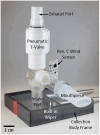Selective Collection of Exhaled Breath Condensate for Noninvasive Screening of Breath Glucose
- PMID: 37401788
- PMCID: PMC11688680
- DOI: 10.1177/19322968231179728
Selective Collection of Exhaled Breath Condensate for Noninvasive Screening of Breath Glucose
Abstract
Background: Although exhaled breath condensate (EBC) is a promising noninvasive sample for detecting respiratory analytes such as glucose, current EBC collection methods yield inconsistent results.
Methods: We developed a custom EBC collection device with a temperature-based algorithm to selectively condense alveolar air for reproducible EBC glucose detection. We characterized the condensate volumes and the corresponding glucose concentrations. We performed a pilot study demonstrating its use during oral glucose tolerance tests.
Results: The novel device selectively captured alveolar air resulting in slightly higher and less variable glucose concentrations than the overall EBC. Participants with type 2 diabetes demonstrated significantly higher blood plasma-EBC glucose ratios than normoglycemic participants.
Conclusions: Temperature-based selective EBC collection allows EBC glucose measurement and is a promising sampling method to distinguish patients with and without diabetes.
Keywords: exhaled breath condensate; glucose; point-of-care diagnostics; type 2 diabetes.
Conflict of interest statement
Declaration of Conflicting InterestsThe author(s) declared the following potential conflicts of interest with respect to the research, authorship, and/or publication of this article: J.C.L. is a co-founder of OmniVis, Inc, EverTrue LLC, and Rescue Biomedical LLC, which have licensed Purdue University technology to develop point-of-care diagnostics and wearable monitoring technologies. At the time of publication, D.T. was an employee of Bristol Myers Squibb, Summit, NJ. All aspects of the study preceded and were independent of this employment. At the time of publication, K.M. was an employee of Eli Lilly and Company, Indianapolis, IN. All aspects of the study preceded and were independent of this employment.
Figures


Similar articles
-
Noninvasive glucose detection in exhaled breath condensate.Transl Res. 2019 Nov;213:1-22. doi: 10.1016/j.trsl.2019.05.006. Epub 2019 May 30. Transl Res. 2019. PMID: 31194942 Free PMC article. Review.
-
Selective Collection and Condensation of Exhaled Breath for Glucose Detection.Annu Int Conf IEEE Eng Med Biol Soc. 2018 Jul;2018:3890-3893. doi: 10.1109/EMBC.2018.8513393. Annu Int Conf IEEE Eng Med Biol Soc. 2018. PMID: 30441212 Free PMC article.
-
Exhaled breath condensate pH decreases following oral glucose tolerance test.J Breath Res. 2015 Dec 15;9(4):047112. doi: 10.1088/1752-7155/9/4/047112. J Breath Res. 2015. PMID: 26669903 Clinical Trial.
-
Effect of temperature control on the metabolite content in exhaled breath condensate.Anal Chim Acta. 2018 May 2;1006:49-60. doi: 10.1016/j.aca.2017.12.025. Epub 2017 Dec 30. Anal Chim Acta. 2018. PMID: 30016264 Free PMC article.
-
Advances in proteomics methods for the analysis of exhaled breath condensate.Mass Spectrom Rev. 2024 Jul-Aug;43(4):713-722. doi: 10.1002/mas.21871. Epub 2023 Dec 27. Mass Spectrom Rev. 2024. PMID: 38149478 Review.
Cited by
-
Beta-Lactam Antibiotics Can Be Measured in the Exhaled Breath Condensate in Mechanically Ventilated Patients: A Pilot Study.J Pers Med. 2023 Jul 17;13(7):1146. doi: 10.3390/jpm13071146. J Pers Med. 2023. PMID: 37511759 Free PMC article.
-
Applications and prospects of biomaterials in diabetes management.Front Bioeng Biotechnol. 2025 Mar 7;13:1547343. doi: 10.3389/fbioe.2025.1547343. eCollection 2025. Front Bioeng Biotechnol. 2025. PMID: 40124248 Free PMC article. Review.
References
-
- Gupta S, Sandhu SV, Bansal H, Sharma D. Comparison of salivary and serum glucose levels in diabetic patients. https://journals.sagepub.com/doi/10.1177/1932296814552673. Published 2014. Accessed April 9, 2020. - DOI - PMC - PubMed
-
- Reim M, Lax F, Lichte H, Turss R. Steady state levels of glucose in the different layers of the cornea, aqueous humor, blood and tears in vivo. Ophthalmologica. 1967;154(1):39-50. https://www.karger.com/Article/Abstract/305147. Accessed April 9, 2020. - PubMed
-
- Optica Publishing Group. In vitro measurements of physiological glucose concentrations in biological fluids using mid-infrared light. https://www.osapublishing.org/boe/abstract.cfm?uri=boe-4-7-1083. Published 2013. Accessed April 9, 2020. - PMC - PubMed
MeSH terms
Substances
Grants and funding
LinkOut - more resources
Full Text Sources
Medical

